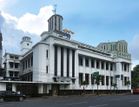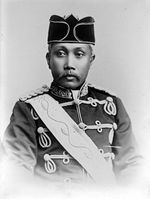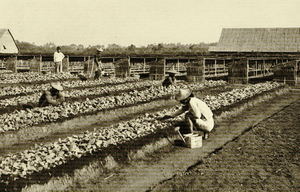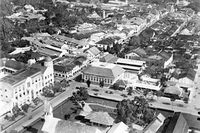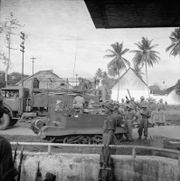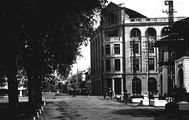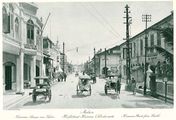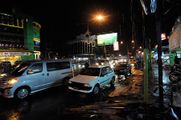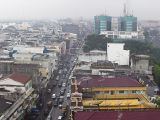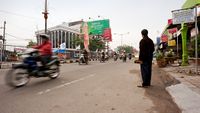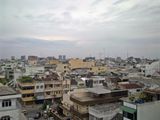ميدان، إندونيسيا
ميدان
Medan Medan-Deli | |
|---|---|
| الترجمة اللفظية بالـ Other | |
| • جاوي | ميدن |
| • الصينية | 棉蘭/棉兰 |
| • تاميل | மேடான் |
من أعلى، ومن اليسار إلى اليمين: وسط مدينة ميدان، المسجد الجامع في كوتا ميدان، مبنى البلدية القديم، قصر ميمون ومباني قديمة حول جالان كسوان. | |
| الكنية: Parijs Van Sumatra (بالهولندية) | |
| الشعار: Bekerja sama dan sama-sama bekerja (نعمل معاً والجميع يعمل) | |
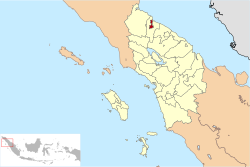 موقع ميدان | |
| الإحداثيات: 3°35′N 98°40′E / 3.583°N 98.667°E | |
| البلد | إندونيسيا |
| المقاطعة | شمال سومطرة |
| تأسست | 1 يوليو 1590 |
| الحكومة | |
| • العمدة | Dzulmin Eldin [1] |
| • نائب العمدة | أخيار ناسوتيون |
| المساحة | |
| • مدينة | 265٫10 كم² (102٫36 ميل²) |
| • العمران | 1٬991٫1 كم² (768٫8 ميل²) |
| المنسوب | 2٫5–37٫5 m (8–123 ft) |
| التعداد (2010 census) | |
| • مدينة | 2٬097٬610 |
| • الكثافة | 7٬900/km2 (20٬000/sq mi) |
| • Urban | 2٬046٬973 |
| • العمرانية | 4٬103٬696 |
| • الكثافة العمرانية | 2٬100/km2 (5٬300/sq mi) |
| صفة المواطن | Medanese |
| منطقة التوقيت | UTC+7 (WIB) |
| مفتاح الهاتف | +62 61 |
| لوحة السيارة | BK |
| الموقع الإلكتروني | Official Government Website |
| ميدان، إندونيسيا | |||||||||||||||||||||||||
|---|---|---|---|---|---|---|---|---|---|---|---|---|---|---|---|---|---|---|---|---|---|---|---|---|---|
| الصينية التقليدية | 棉蘭 | ||||||||||||||||||||||||
| الحروف المبسطة | 棉兰 | ||||||||||||||||||||||||
| |||||||||||||||||||||||||
ميدان (Medan ؛ النطق الإندونيسي: [meˈdan]; إندونيسية: Kota Medan) هي عاصمة مقاطعة شمال سومطرة في إندونيسيا. وتقع على الساحل الشمالي، وبلغ تدادها 2,097,610 نسمة في تعداد 2010. مدان هي خامس أكبر مدينة في إندونيسيا حسب التعداد بعد جاكرتا، سورابايا، باندونگ و بكاسي، وهي أيضاً ثالث أكبر مدينة حسب المساحة (بعد جاكرتا وسورابايا)، وأكبر مدينة إندونيسية خارج جاوة.[2][3][4] منطقة امتدادها العمراني (مترو ميدان) يتكون من 18 بلدية أو حي يسكن فيهم 4,103,696 نسمة في تعداد 2010.[5] المدينة يجاورها Deli Serdang Regency إلى الشرق والجنوب والغرب، ومضيق ملقا إلى الشمال، مما يجعل المدينة ذات أهمية استراتيجية واقتصادية إذ أن مضيق ملقا هو أحد أهم الممرات الشحن البحري في العالم.
Medan is the gateway to the western part of Indonesia where Belawan Port and Kuala Namu International Airport which is the second largest airport in Indonesia are exist. Access to the port of Belawan from Medan city center down south to industrial district of Tanjung Morawa is equipped by Belmera Toll Road، أول طريق مدفوع خارج جزيرة جاوة.
The city was founded by the Guru Patimpus, the karonese man which named a swampy land in confluence of نهر دلي ونهر بابورا as Kampung Medan as the first settlement around and then in 163 The Deli Sultanate was established by Tuanku Gocah Pahlawan the 1st King or Sultan. In the 18th century, the 8th Sultan السلطان محمود الرشيد پركاسا علم opening a relationship with the Dutch, and Jacob Nienhuys a Dutch tobacco merchants pioneered the opening of the tobacco plantation in Deli Land that make the name changed to Medan-Deli when it was established by Dutch tobacco commerce after the formation of the شركة دلي. With the help from the 9th Sultanate السلطان مأمون الرشيد پركاسا علم also by the most known Chinese businessman duo at that time Tjong Yong Hian and Tjong A Fie, the rapid development of the economy transform Medan-Deli into a big trading center with the nickname as het land dollar aka the land of the money. The Deli Railway was established for shipping rubber, tea, timber, palm oil, and sugar industries from the city to Belawan, a port town up to north area. بعد الاستقلال، كانت ميدان عاصمة شرق سومطرة، إحدى ولايات الولايات المتحدة الإندونيسية أثناء 1449 وحتى 1950 ثم تغيرت لتصبح عاصمة شمال سومطرة في منتصف ع1950.
Medan was dubbed by the Dutch Parijs van Soematra due to the city's resemblance to پاريس. Lamudi, a worldwide real estate portal, recognized Medan as one among six cities in Asia to feature and preserve several colonial architectural sites, while accompanying its growth as a metropolitan city.[6]
في السنوات الأخيرة، the development growth rise rapidly with a large scale infastructure such as a new airport, seaport, elevated railroad, toll roads, and also a planned mass rapid transit. Bringing a major-scaled properties, mixed developments and housings is being built. One of the favorable markets in the country's property industry outside Java is Medan. The rising demand in North Sumatra's capital is also due to Java's increasingly rapid population growth. The way that a new airport has been developed to become bigger and grander has helped make Medan a more attractive place to visit.[7] Residential property prices in Medan have trended upward over the period from 2013 to the first quarter of 2015, according to Bank Indonesia (BI). According to BI, Medan’s residential property price index rose from 205.24 in the fourth quarter of 2013 to 212.17 in the fourth quarter of 2014, and to 214.41 in the first quarter of 2015.[8]
أصل الاسم
حسب يوميات تاجر برتغالي في مطلع القرن السادس عشر، فإن إسم "ميدان" كان مشتقاً من الكلمة التاميلية Maidhan, also known as Maidhāṉam (بالتاميل: மைதானம்)، وتعني أرض، مأخوذة من لغة الملايو. أحد قواميس كارو-إندونيسيا التي كتبها داروِن پرنست SH والمنشور في 2002 يقول أن ميدان يمكن أن تـعرَّف بأنها "يتعافى" أو "يصبح أحسن".
التاريخ
في الأزمنة القديمة كانت مدينة ميدان تُعرف بإسم Kampung Medan (Medan Village). It was a piece of swampy land with an area of approximately 4000 ha. Some of the rivers crossing the city of Medan drain into the Straits of Malacca. These rivers are Sei Deli, Sei Babura, Sei Sikambing, Sei Denai, Sei Putih, Sei Percut and Muara Belawan.
بدأت مدينة ميدان بوصفها قرية تسمى كامپوڠ ميدان (Kampung Medan) (أي قرية ميدان). تأسست كامبونغ ميدان على يد جورو باتيبس (Guru Patimpus) في تسعينيات القرن السادس عشر. ونظرًا لأن مدينة ميدان تقع على تاناه ديلي (Tanah Deli) (أرض ديلي)، فيشار إلى كامپوڠ ميدان أيضًا بميدان-ديلي. فالموقع الأصلي لكامبونغ ميدان هو منطقة يلتقي فيها نهر ديلي ونهر بابيورا (Babura).
وطبقًا ليوميات تاجر برتغالي في أوائل القرن السادس عشر، فقد ذكر أن الاسم ميدان مشتق في الحقيقة من المدينة المنورة وهي مدينة مقدسة تقع في غرب المملكة العربية السعودية. في حين أن مصادر أخرى أشارت إلى أن الاسم ميدان مشتق في الحقيقة من اللغة الهندية هندي وكلمة ميدان "Maidan" والتي تعني "الأرضية" أو "الأرض" (كما هو الحال في براغاتي ميدان في دلهي). ذكرت أحد قواميس كارو-إندونيسيا الذي ألفه داروين برينست (Darwin Prinst) ونشره عام 2002، أن كلمة ميدان من تعريفاتها "التحسن" أو "أن تصبح أفضل".
ينحدر أول من سكن مدينة ميدان من شعب ملايو القادم من شبه جزيرة ملايو والمانديلينغ القادم من مجلس جنوب تابنيولي (South Tapanuli Regency) بالإضافة إلى شعب كارو القادم من مرتفعات كارو. ولم يكن حتى عهد سلطان آتشه, السلطان اسكندر مودا, الذي أرسل قائده العسكري, المحارب الاميرال خوجة بنتان (Gocah Pahlawan Laksamana Khoja Bintan), ليصبح ممثل سلطنة آتشه'في تاناه ديلي, حتى بدأت سلطنة ديلي بالنمو. وقد حفز هذا النمو من نمو كلاً من عدد السكان والثقافة في مدينة ميدان على حد سواء. وفي السنة الثانية من عهد سلطان ديلي (في الفترة بين 1669-1698)، نشبت معركة بين أسلحة الفرسان في مدينة ميدان.
ولم تشهد ميدان أي تقدم ملحوظ حتى ستينيات القرن التاسع عشر، عندما بدأ المستعمرون الهولنديون في إخلاء الأرض وتجهيزها لزراعة التبغ. وسريعًا أصبحت ميدان مركزًا للحكومة والنشاط التجاري، لتهيمن على تنمية المنطقة الغربية بإندونيسيا.
حكم الهولنديون تاناه ديلي بدءًا من عام 1658, بعد السلطان إسماعيل, حاكم سلطنة سياك, حيث قام بالتنازل عن بعض الأراضي التي حكمها ذات مرة منها ديلي, ولانجكات, وسيردانج. وفي عام 1915، أصبحت ميدان رسميًا عاصمة لمقاطعة سومطرة الشمالية، وأصبحت مدينة رسميًا 1918.
وحاليًا أصبحت الكثير من المباني المعمارية التاريخية في ميدان من العصر الاستعماري عرضة للإزالة لإفساح المجال أمام إقامة المباني الحديثة (مراكز التسوق، والمرائب، وغيرها).[9]
تأسيس كوتا ميدان
In early days, the natives called the area as the Land of Deli (Indonesian: Tanah Deli), it starts from Ular River to the Wampu River in Langkat while the Deli Sultanate in power at the time of his territory does not cover the area between the two rivers.
سلطنة دلي
في القرن السادس عشر كانت توجد مملكة تُدعى آرو، تتمركز حيث توجد اليوم بلدة "دلي توا" (جنوب ميدان). وفي 1612 the Acehnese Sultan إسكندر مودا defeated Aru. The Acehnese appointed Hisyamsudin (later he changed his name to "Tuanku Gocah Pahlawan"), titled as Laksamana Kuda Bintan as their representative in this kingdom of East Sumatra. In 1632 Aceh established the Deli Sultanate (جاوي: کسلطانن دلي) and Gocah Pahlawan became the first king. Gocah Pahlawan opens a new land in Sungai Lalang and Percut. As Mayor and Deputy of Sultan of Aceh as well as by utilizing the oversized of Aceh Imperium, Gocah Pahlawan managed to expand its territory, thereby covering Percut Sei Tuan and Medan Deli district now. He also founded the villages of Gunung Barus, Sampali, Kota Bangun, Pulo Brayan, Kota Jawa, Kota Rengas and Sigara-gara. He died in 1669 and was followed by his son "Tuangku Panglima Perunggit" who moved the center of the kingdom to Labuhan Deli, which then proclaimed the independence of Deli Sultanate from Aceh Sultanate in 1669, with its capital in Medan Labuhan, approximately 15 km from the city center now.
The third king, "Tuanku Panglima Padrap" (ruled 1698–1728), during his reign, he moved the kingdom to Pulo Brayan due to flood. The fourth king, "Tuanku Panglima Pasutan", (ruled between 1728–1761). He organized the kingdom in four tribes, each led by a Datuk (a Malay title for high ranking persons). The fifth king, "Tuanku Panglima Gandar Wahib", (حكم 1761–1805), during his time the Datuks increased their power.
The sixth ruler was "Sultan Amaluddin Mengedar Alam", (ruled 1805–1850). سلطنة سياك during his years, became a stronger influence in Deli than the Acehnese Sultanate, the ruler was given the title to malayness name: Sultan. The seventh ruler is "Sultan Osman Perkasa Alam" (ruled 1850 to 1858), during his leadership the Deli sultanate became autonomous.
The eighth ruler, "Sultan Mahmud Al Rasyid Perkasa Alam" (ruled 1858–1873) started the relationship with the Dutch, a relationship that became rather intimate. The next ruler are "Sultan Ma'mun Al Rashid Perkasa Alamyah", ruled from 1873 to 1924 when the tobacco trade expanded. He moved the kingdom to Medan and finished the construction of the Maimun Palace in 1888. He also built the grand mosque of Al Ma'shun which is commonly known as (Great Mosque of Medan) now in 1907, he became known as the builder of early Medan in corporation with the Dutch and "Tjong Yong Hian" and Tjong A Fie, a Chinese businessman brother and also a Kapitans who built a large plantation business in Deli. They all bringing Medan-Deli as new development area including business center such as Bank, office, plantation area, housing, railroad and port. The tenth "Sultan Amaluddin Al Sani Perkasa Alamsyah" (ruled 1924–1945) expanded harbors, the commerce increased during his period. At the declaration of Indonesian Independence, the Sultan recognized the sovereignty of the republic and was in return given an important function as administrator of Deli-Malay traditions and culture.
The Sultanate of Deli still are exist till now, even though the administration power has been replaced with Mayor, the current sultan are "Sultan Mahmud Lamanjiji Perkasa Alam" the 14th sultan, (ruled since 2005). Coronated the age of eight, he is the youngest sultan that has been coronated in Deli Sultanate history.
فترة جزر الهند الشرقية الهولندية

افتتاح قناة السويس في 1869 meant strongly intensified traffic between Europe and the Far East. The Dutch started the shipping company Stoomvaart Maatschappij Nederland that quickly expanded to 43 steamships in 1877. The English, however, had already 3,000 ships in those days. A journey from Europe to Indonesia took approximately 40 days. Genoa, Italy became the new transit harbor for passenger ships after the opening of the Gotthard Tunnel in Switzerland. The journey was reduced to 23 days and 20 hours to باتاڤيا (Jakarta). The ships also became bigger and more comfortable.
This resulted in an increase in cruise ships carrying predominantly white European origin came to Dutch East Indies tourists for a tour of the region, including Medan as the largest tobacco plantation in Dutch East Indies at that time. To accommodate the tourists, it is very necessary to have European-class hotels. Therefore, in 1898, a Dutch businessman named Aeint Herman de Boer built Hotel de Boer in the northwest of the Esplanade (now Lapangan Merdeka Medan).
Exports were very dependent on British shipping in 1890 when Sabang became a bunker harbor. Belawan got its harbor in 1923. The shipping company Koninklijke Paketvaart Maatschappij (KPM) was established for the purpose of shipping valuable Deli Company tobacco, which was shipped to Batavia. This cargo was almost as valuable and stringent rules regulated its handling. It was strictly forbidden to stow anything on top of the tobacco and coolies were not even to walk on it when they worked in the hatches.[10]
Cleaning of roads in Medan was, until 1912, done by prisoners. After that free coolies got the job. In 1917 the authorities started to use horse-drawn carts, equipped with brooms for the cleaning. In 1928 the horse-drawn carts were replaced by motorized vehicles. The first newspaper was the ‘Deli Courant’, established in 1885. It did not appear daily. In 1898, Joseph Hallermann, a German, established the daily ‘De Sumatra Post’, which survived until 1939.
There were planters in Medan from many countries: England, the Netherlands, USA, France, Germany, Poland, and Switzerland. Many of them became very rich and led an affluent lifestyle. Medan became known as the Paris of Sumatra. Up till today, the area in downtown where the old airport is located is called Polonia, a name given by a Polish aristocrat who once owned a plantation here. One area of Medan is still called Helvetia (the old name of Switzerland). This name was given by a plantation owner from Switzerland.
مزارع التبغ

Medan has not develop rapidly until the 1860s, when the Dutch authorities began to release new land for tobacco plantations. Jacob Nienhuys, Van der Falk, and Elliot, a Dutch tobacco merchants pioneered the opening of the tobacco plantation in Deli Land. Nienhuys previous tobacco business in Java, moved to Deli invited to an Arab from Surabaya named Said Abdullah Bilsagih, brother in law of Sultan Deli, Mahmud Perkasa Alam. Nienhuys first gardening tobacco on land owned by the Sultan of Deli of 4,000 hectares in Tanjong Spassi, near Labuhan. March 1864, Nienhuys sent samples of his crop of tobacco to Rotterdam, Netherlands to test its quality. Apparently, the tobacco leaves are considered high quality for cigar materials. Bounced Deli name as producer of the best cigar wrappers for Europeans.
The tobacco treaty was signed by the Sultan of Deli and the Dutch in 1865. After two years, Nienhuys together Jannsen, P.W. Clemen, and Cremer founded the company De Deli Maatschappij abbreviated Deli Mij in Labuhan. In 1869, Nienhuys move the head office of Deli Mij to Kampung Medan. The new office was built on the confluence of Deli and Babura river, precisely at the office of PTPN II (ex PTPN IX) now. With the transfer of the office, Medan quickly became the center of government activity and trade, as well as areas most dominating developments in western Indonesia. The rapid development of the economy transform Deli into a big trading center with the nickname as het land dollar aka the land of the money. Then, they open up new plantations in the area Martubung and Sunggal in 1869, as well in Sungai Beras and Klumpang 1875, bringing the total to 22 plantation companies in the year 1874. Given the activities of the tobacco trade is already very broad and growing. Thus the "Kampung Medan" is becoming increasingly crowded and then developed with a name that is known as the Medan-Deli.
The development of Medan-Deli a trading center has been pushed into the center of government. In 1879, Capital Assistant of Deli Residen moved from Labuhan to Medan. On 1 March 1887, the capital of the Resident of East Sumatra also moved from Bengkalis to Medan Deli Sultanate Palace which was originally located in Kampung Bahari (Labuhan) and Pulo Brayan also moved with the completion of Maimoon Palace on May 18, 1891, and thus the Capital Deli has officially moved to Medan.
نمو ميدان-دلي
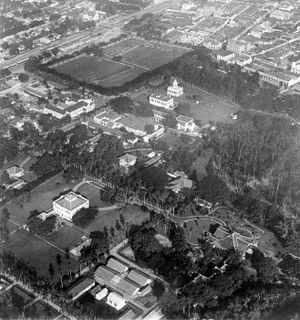
In 1915, the Residency of East Sumatra enhanced its status to Gubernermen. In 1918 the city of Medan officially became Gemeente (Municipal) with Mayor Baron Daniël Mackay. Based on the "Acte van Schenking" (Grant Deed) No. 97 Notary J.M. de-Hondt Junior, dated November 30, 1918, the Sultan of Deli handed over the land of Medan-Deli to the Gemeente, thus officially becoming the region under the direct rule of the Dutch East Indies. In the early days of this township, Medan still consists of four villages, namely Kampung Kesawan, Kampung Sungai Rengas, Kampung Petisah Hulu and Kampung Petisah Hilir.
In 1918 there were 43.826 residents of Medan, made up of 409 Europeans, 35,009 Native Indonesians, 8,269 Chinese and 139 East foreign such as Indians.
Since then the Medan developed more rapidly. Various facilities are built. Some of these include the Office of Experiment Stations named AVROS in Kampung Baru (1919), now RISPA, the railway of Pangkalan Brandan - Besitang (1919), Tirtanadi Water Tower (1908), American Consulate (1919), Teacher school on Jl. H.M. Yamin now (1923), Mingguan Soematra (1924), Pool Association Medan (1924), Central Market (Grote Markt/Toa Pa Sat or 大巴刹), St. Elizabeth Hospital, Eye Hospital and Kebun Bunga Sports field (1929).
Historically the development of the city of Medan, since the beginning has been positioned at the center of trade (export-import) since the past. being Medan choosed as the Deli capital also has made the city of Medan developed into a center of government. until now beside one of the areas of the city, also serves as the capital of North Sumatra province.
مطار ميدان الجديد
تم انشاء مطار دولي جديد علي بعد ساعة من المدينة مطار كوالا نامو ..
وتسليم المطار القديم الواقع داخل المدينة للجيش
الاحتلال الياباني وعصر ما بعد الاستقلال
The Japanese invasion began in 1942 throughout Indonesia. The Japanese troops who landed in Sumatra were XXV soldiers who were based in Shonanto which is currently known as Singapore, they landed on the 11 and 12 March 1942. The force was made up of Guard Division 2nd Empire coupled with the 18th Division led by Lieutenant Nishimura. They landed in four locations: Sabang, Ulele, Kuala Bugak (near Perlak, Aceh now) and Tanjung Tiram (Batubara region now). The Tanjung Tiram troops were the soldiers who went to the city of Medan, they rode bikes that they bought from the locals, and the Japanese troops occupied Medan until 1945.
After the Independence, the central government began to establish RIS (United States of Indonesia) In 1949, and Medan became the capital of state of East Sumatra with Tengku Mansur as State Mayor. After the RIS era ended, Medan officially became the capital of North Sumatra. the city development was remain stagnant until the 1970s, with big developepment, especially on palm oil and rubber plantation company headquarters, Medan has been become the busiest city outside of Java. The big migration program bring a lot Javanese and the Bataks people began to settle in the city as many people from Java island and rural part of the province seek for a job.
Medan hit a million population in 1998 and 2 million in 2010, the city has begun to gain Metropolis status around 2006.
الجغرافيا
Medan is in the northeastern part of Sumatra island, in Sumatera Utara province. Medan lies on the banks of the Deli River and Babura River which feed into a naturally sheltered harbor and then into the Straits of Malacca, it has helped the city grow in significance as a trading port.[11] Its elevation varies between 2.5 و 37.5 متر (8 ft 2 in و 123 ft 0 in) above sea level. Medan is close to the Barisan Mountains which is located in the southern part of the city and close to volcanoes such as Sibayak Mountain and Sinabung Mountain (located as far as 50 إلى 70 كيلومتر (31 إلى 43 ميل) from the city).
المناخ
Under the Köppen climate classification, Medan features a tropical rainforest climate with no real dry season.[12] Medan does have noticeably wetter and drier months, with its driest month (February) on average seeing about one third of the precipitation of its wettest month (October). Temperatures in the city average approximately 27 °C (81 °F) throughout the course of the year. Annual precipitation in the Medan is around 2،200 ميليمتر (87 بوصات).
| بيانات المناخ لـ ميدان | |||||||||||||
|---|---|---|---|---|---|---|---|---|---|---|---|---|---|
| الشهر | ينا | فب | مار | أبر | ماي | يون | يول | أغس | سبت | أكت | نوف | ديس | السنة |
| متوسط القصوى اليومية °س (°ف) | 31.6 (88.9) |
32 (90) |
32.7 (90.9) |
32.9 (91.2) |
33.4 (92.1) |
33.3 (91.9) |
32.9 (91.2) |
33.3 (91.9) |
31.9 (89.4) |
31.7 (89.1) |
31 (88) |
30.9 (87.6) |
32.3 (90.1) |
| متوسط الدنيا اليومية °س (°ف) | 22.2 (72.0) |
22.6 (72.7) |
23.2 (73.8) |
23.5 (74.3) |
23.3 (73.9) |
23.6 (74.5) |
23.5 (74.3) |
22.8 (73.0) |
22.2 (72.0) |
22.6 (72.7) |
23 (73) |
22.5 (72.5) |
22.9 (73.2) |
| متوسط تساقط الأمطار mm (inches) | 92 (3.6) |
115 (4.5) |
97 (3.8) |
157 (6.2) |
178 (7.0) |
141 (5.6) |
167 (6.6) |
185 (7.3) |
263 (10.4) |
387 (15.2) |
253 (10.0) |
228 (9.0) |
2٬263 (89.2) |
| Average rainy days | 14 | 19 | 13 | 18 | 22 | 15 | 13 | 17 | 24 | 22 | 20 | 19 | 216 |
| Mean monthly ساعات سطوع الشمس | 96 | 106 | 111 | 105 | 111 | 144 | 124 | 108 | 78 | 74 | 84 | 84 | 1٬225 |
| Source 1: World Meteorological Organization[13] | |||||||||||||
| Source 2: Deutscher Wetterdienst (sun, 1961–1990)[14][أ] | |||||||||||||
Located in the central part of Deli Serdang Regency, Medan is surrounded by satellite cities and towns such as Binjai, Lubuk Pakam, Tanjung Morawa, Tembung, Percut Sei Tuan, and Labuhan Deli which help the city become a new urban area in Indonesia which known as 'Mebidang' (Medan, Binjai, Deli Serdang)
الحوكمة

العمدة
Medan was governed by mayor Dr. H. Abdillah Ak, MBA (appointed for the period 2005–2010). However, Abdillah and his vice mayor were caught by Indonesian Corruption Eradication Commission officials in 2008. Syamsul Arifin, the Governor of North Sumatra Province, then appointed Affifudin Lubis to become the acting mayor. In 2009, Affifudin Lubis resigned as mayor and the Governor then appointed Rahudman Harahap as mayor. Because Rahudman wanted to be a candidate in the 2010 mayor election, he too resigned from the office. Then Syamsul Arifin himself became the acting mayor. In the 2010 mayor election, Rahudman Harahap won the election. Rahudman was arrested due to corruption which result in his deputy Dzulmi Eldin officially became the acting mayor.[15]
التقسيم الاداري
Medan is divided into 21 districts (إندونيسية: kecamatan), tabulated below, and sub-divided into 151 neighborhoods or villages (kelurahan):[16][17]
Based on the map, the city are centralised around Medan Petisah, Medan Baru, Medan Polonia, Medan Maimun, Medan Kota, and West Medan which is act as City Center. Medan Labuhan is one of the largest districts by area other than Medan Belawan and Medan Marelan which is lies on the northern part of the city. Medan Tuntungan serves as the gateway to Karoland regency, Medan Helvetia to Binjai City and Langkat and Medan Amplas to Tebing Tinggi and Pematang Siantar.
الديمغرافيا
The city is Indonesia's fourth most populous after Jakarta, Surabaya, and Bandung, as well as Indonesia's largest city outside of Java island. The population has risen from 568,000 in 1968[18] fourfold to 2.1 million in 2010. Much of the population lies outside its city limits, especially in Deli Serdang Regency. The official Metropolitan area (Wilayah Metropolitan Medan) inhabited by 4,144,583 people in 2010.
| Administrative division | Area (km²) | Population (2010 Census) | Population (2015 Est) | Population density (/km²) |
|---|---|---|---|---|
| Medan (City) | 265.10 | 2,109,330 | 2,210,624 | 8,339 |
| Binjai (City) | 90.24 | 246,010 | 264,687 | 2,933 |
| Deli Serdang Regency | 2,384.62 | 1,789,243 | 2,029,308 | 851 |
| Greater Medan | 2,739.96 | 4,144,583 | 4,504,619 | 1,644 |
Source: BPS Sumut[19]
الأعراق واللغات

As for Ethnicity, the Javanese, Batak (including Mandailing and Karo people), and Chinese are the major ethnics in Medan, with sizeable Minangkabau and Malay people and also has small Acehnese, Indians, Nias, and Sundanese people. Medan also has foreign residents from India, Sri Lanka Bangladesh, تايلند, China, Taiwan, Middle East and other Asian countries.[20]
| Ethnic groups in Medan, 2010 | ||
|---|---|---|
| العرقية | التعداد | النسبة |
| Batak including Karo and Mandailing people |
743,432 | 33.63% |
| Javanese | 663,380 | 30.03% |
| Chinese | 368,068 | 16.65% |
| Minangkabau | 168,007 | 7.60% |
| Malay | 145,680 | 6.59% |
| others Indian and Acehnese |
115,615 | 5.23% |
الدين
Great Mosque of Medan or simply locally known as Masjid Raya
Vihara Gunung Timur, the oldest Taoist also Buddhist temple in Sumatra Island
Sri Mariamman Temple, main Hindu temple in Medan
الاقتصاد
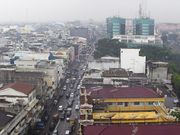
الثقافة
المعالم

المتحف
معرض الصور
- Gallery of panoramic and street view images from Medan
الهامش
- ^ "Eldin resmi jadi Walikota Medan". 2014-06-18. Retrieved 2015-03-10.
- ^ "Indonesians torch US flag in protest in country's third-largest city". Fox News. 18 September 2012. Archived from the original on 23 August 2016. Retrieved 12 September 2016.
{{cite news}}: Unknown parameter|deadurl=ignored (|url-status=suggested) (help) - ^ http://swa.co.id/swa/trends/marketing/erafone-mega-store-tancapkan-kaki-di-kota-medan
- ^ SWA 16th Edition : Indonesia Best Cities for Business 2016
- ^ http://www.citypopulation.de/php/indonesia-sumatera-admin.php
- ^ Feriawan Hidayat (March 29, 2015). "Enam Kota Asia Paling Trendi untuk Menetap".
- ^ The Jakarta Post (December 26, 2014). "Property markets outside Java have growth potential".
- ^ Analysis (2015). "Transport infrastructure a key part of Medan's development plans".
- ^ Jakarta Post article 25 May 2010
- ^ History of Place History of Medan
- ^ Usman Pelly, Sejarah Kota Madya Medan, 1950–1979; Departemen Pendidikan dan Kebudayaan R.I., Proyek Inventarisasi dan Dokumentasi Sejarah Nasional, Direktorat Sejarah dan Nilai Tradisional, 1985
- ^ "Medan, Indonesia Köppen Climate Classification (Weatherbase)". Weatherbase. Retrieved 4 July 2015.
- ^ "World Weather Information Service–Medan". World Meteorological Organization. Retrieved June 18, 2015.
- ^ "Station 96035: Kualanamu Medan". Global station data 1961–1990—Sunshine Duration. Deutscher Wetterdienst. Retrieved June 18, 2015.
- ^ koran-indonesia.com KPK Arrests Mandailing Natal Mayor for Alleged Bribery
- ^ http://www.pemkomedan.go.id Info Data Kota Medan
- ^ http://www.bppt-pemkomedan.info Kondisi Geografis Medan
- ^ Ensiklopedi Umum, Penerbitan Jajasan Kanisius, 1973
- ^ http://sumut.bps.go.id/frontend/linkTabelStatis/view/id/499 Jumlah Penduduk dan Rumah Tangga Menurut Kabupaten/Kota, 2015
- ^ Leo Suryadinata, Evi Nurvidya Arifin, Aris Ananta, Indonesia's Population: ethnicity and religion in a changing political landscape, Institute of Southeast Asian Studies, 2003.
- ^ Indonesia's Population: Ethnicity and Religion in a Changing Political Landscape. Institute of Southeast Asian Studies. 2003. ISBN 9812302123
ملاحظات
- ^ Station ID for Kualanamu Medan is 96035 Use this station ID to locate the sunshine duration
وصلات خارجية
 ميدان، إندونيسيا travel guide from Wikivoyage
ميدان، إندونيسيا travel guide from Wikivoyage- Official Government website (إندونيسية)
- Medanesia – Medan Forum (إندونيسية)
- CS1 errors: unsupported parameter
- Short description is different from Wikidata
- Pages using infobox settlement with possible motto list
- Pages using gadget WikiMiniAtlas
- Articles containing صينية-language text
- Pages with plain IPA
- Articles containing إندونيسية-language text
- Pages using Lang-xx templates
- Articles containing تاميلية-language text
- Pages using columns-list with unknown parameters
- Pages with empty portal template
- Regencies of North Sumatra
- كوتا ميدان
- أماكن مأهولة في شمال سومطرة
- مدن إندونسيا
- عواصم مراكز إندونسيا
- عواصم مقاطعات إندونسيا
- أماكن مأهولة تأسست في 1590





